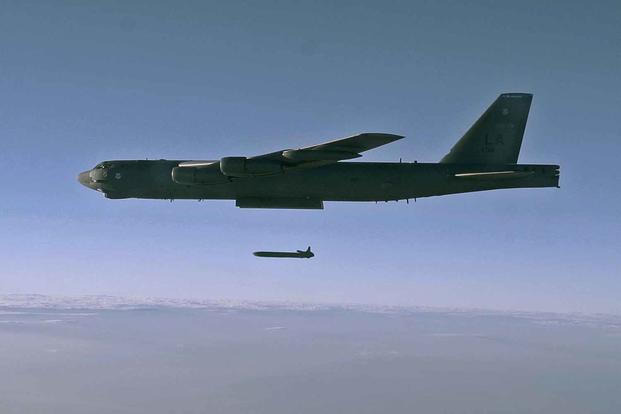In Surprise, Air Force Picks Raytheon to Build New Cruise Missile
Military.com | By Oriana Pawlyk
The U.S. Air Force has chosen Raytheon Co. as the sole-source manufacturer to proceed with the service’s new nuclear cruise missile, which is intended to be launched from aircraft such as the B-52 Stratofortress.
The service on Friday selected Raytheon’s design for the Long Range Stand Off weapon, known as LRSO — which is currently in the technology-maturation and risk-reduction phase — over Lockheed Martin Corp. The decision to choose a single company will allow the LRSO office to begin exploring how it can “redirect funding to critical areas and potentially move some activities into the TMRR phase currently scheduled for the Engineering and Manufacturing Development (EMD) phase, including flight tests” at a faster pace, according to a service news release.
While officials didn’t call the latest decision a down-select between the two companies — a move that wasn’t expected until fiscal 2022 — the service said it came to the choice after an “extensive evaluation of [both companies’] contractor programmatic and technical approach.”
“This is not a down-select per se,” said Elizabeth Thorn, the Air Force Nuclear Weapons Center’s LRSO system program manager, in the release. “Instead, we are reframing our relationship with Lockheed Martin to focus on specific technology maturation we believe either has future applicability for the final LRSO design or will reduce overall program risk.”
In 2017, the service awarded contracts to Lockheed and Raytheon to begin preliminary work on LRSO. The agreements were valued at $900 million each and were to last almost five years “to mature design concepts and prove developmental technologies,” the Air Force said at the time.
The LRSO program will replace the 1980s-era AGM-86B Air Launched Cruise Missile, known as ALCM, providing an air-launched capability as part of the nuclear triad.
“This early off-ramp of a contractor is completely in line with the existing LRSO acquisition strategy, which included periodic reviews to assess contractor designs,” said Maj. Gen. Shaun Morris, Air Force Nuclear Weapons Center commander and program executive officer for strategic systems.
“Lockheed Martin has been an excellent contractor and partner throughout the TMRR effort, and this pivot to Raytheon does not represent a lack of effort or commitment on their part. Lockheed Martin has supported the nuclear enterprise for decades, and we continue to value their expertise in sensors and nuclear certification and surety,” he said.
Lockheed said in a statement that it is working with the program office and the Air Force to close out its work in the TMRR phase, though it will still be involved to support the LRSO mission, as Thorn explained.
“We’ve supported our nation’s nuclear triad for more than 60 years and look forward to working with the [Air Force] to support the LRSO mission, specifically leveraging our sensor technology and nuclear certification and surety expertise,” the company said.
Despite the announcement, a formal contract award for the next phase won’t occur until fiscal 2022, as previously planned, Raytheon added.
The LRSO is planned for the B-52, as well as the B-2 Spirit and the future B-21 Long-Range Strike Bomber.
Earlier this month, Gen. Timothy Ray, head of Air Force Global Strike Command, told Air Force Magazine that a conventional version of the LRSO is also a plausible fit for the B-1B Lancer, though the aircraft is not slated to receive the weapon because it is no longer a nuclear-capable bomber.
While there’s no requirement to create a conventional version of LRSO, Ray said it’s the range he’s interested in.
“I think that’s going to be a very, very good missile,” he told the magazine.



